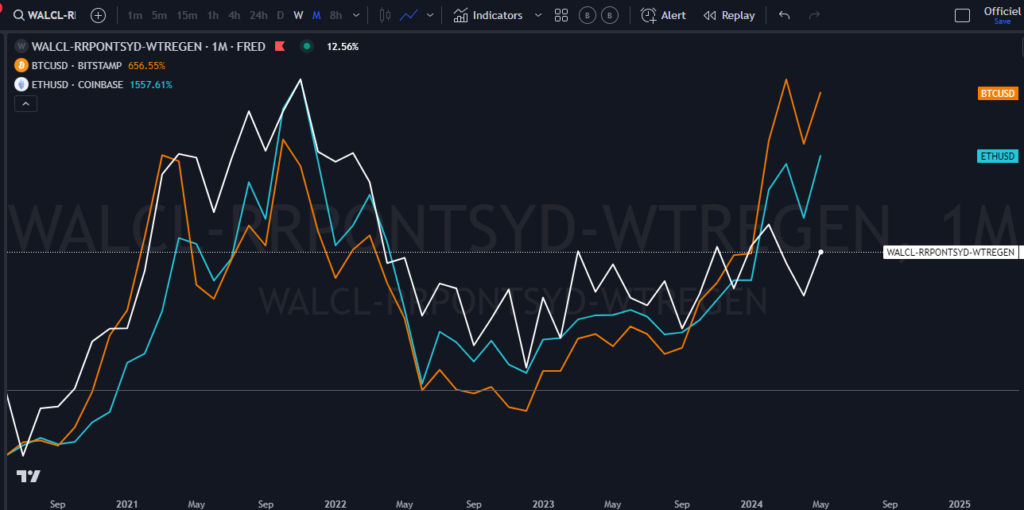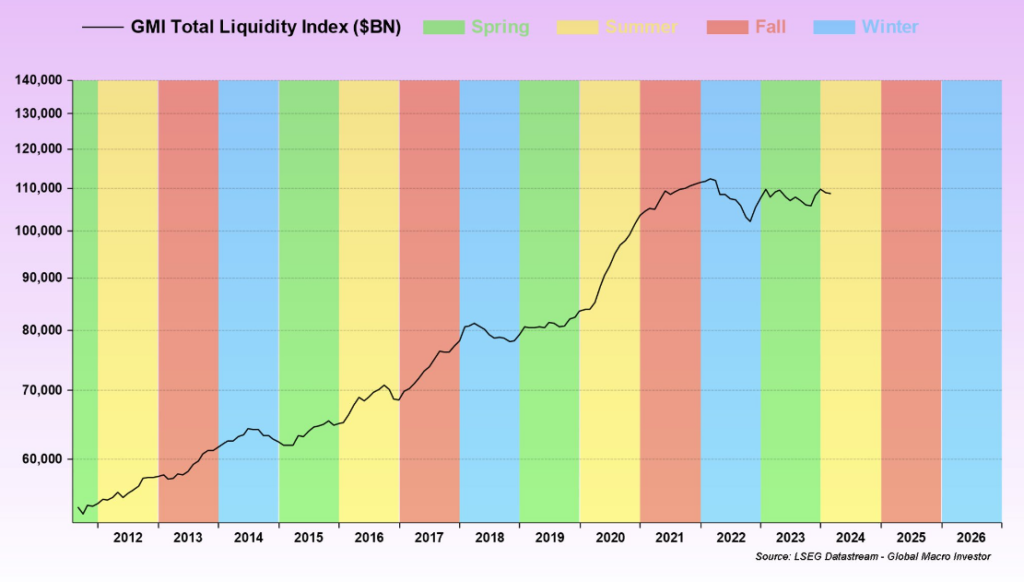News
Crypto: Is Ethereum catching up?

7:41 ▪ 7 min reading ▪ by Laetitia B.
In the past, each rise has gone through different phases stimulated by a rotation of capital. In general, Bitcoin is often the leader of the bull run and the favorite in the early stages. Following the weaker performance of Ethereum compared to bitcoin, we will focus on the factors favorable to a rotation of capital towards Ethereum.
The principle of asset rotation
In traditional finance, there are several types of asset turnover. This may involve a sector rotation (technology, industrial, financial, healthcare, etc.) or a rotation of asset types (bonds, stocks, commodities, forex, etc.). Capital moves depending on the context and the economy. Rotation can come from taking profits after a significant performance to move towards another sector or a less valued type of asset while following the economic context. This is often the case between cyclical and defensive sectors for example.
Let’s also take an example over a very long term horizon, that is to say over several decades, we can see this cyclical rotation between raw materials and the S&P500 index in the graph below:
This type of chart highlights that in the coming years, the performance of commodities should be more advantageous than that of the S&P500.
The different phases of crypto
When you look at the cryptocurrency market, there are several phases in terms of rotation, whether between bitcoin, Ethereum, large caps and altcoins. And usually that comes from a gradual rotation.
Phase 1: Bitcoin is the leader, the store of value in the crypto market. It is the oldest and most democratized in the sphere of cryptocurrencies. It is on bitcoin that the first capital inflows arrive at the start of a bull market. Since 2024, bitcoin has been available in spot ETF form, which is an advantage in stimulating demand. And at the same time, when demand is stimulated, capital inflows increase. During phase 1, Bitcoin tends to outperform Ethereum. And only when Ethereum begins to approach Bitcoin’s performance is phase 2 near. We can possibly see this rotation with the example below which highlights the ETC/BTC ratio:
Phase 2: Ethereum, which is the number 2 cryptocurrency in the cryptosphere, outperforms bitcoin. This can be seen in the chart below with the 2021 bull run.
Phase 3: It is the turn of large caps (Doge, LTC, XRP, etc.) to outperform bitcoin.
Phase 4: Altcoin season begins when there is significant capital turnover. That is, the money invested in bitcoin at the start of the bull run shifts to other cryptocurrencies, small and mid caps, and even memes. During the altcoin season, we see a reduction in Bitcoin dominance. Here is a graph that highlights this:
To better illustrate this generally, here is the timeline below:
The economic environment and the different phases of the cryptocurrency markets
The evolution of cryptocurrencies is quite cyclical, just like the economy. That is to say, we find cycles of growth and cycles of decline. Like any riskier asset class, it evolves in a favorable and accommodating context. A favorable context can be defined in several ways. For example, when growth rebounds, there is an acceleration in growth, which constitutes a favorable environment for cryptocurrencies. Consumer confidence is positive, which encourages capital inflows. Conversely, when we face an economic downturn, it is often represented by a bear market in cryptocurrencies. Each cycle often lasts on average a year and a half to two years, just like economic cycles. So, if you add up a bull market and a bear market, that’s 4 years, just like the halving process:
Another positive element for performance is also liquidity. When liquidity is abundant, cryptocurrencies thrive. For example, injections of liquidity during COVID, capital circulated more in the markets. Financial conditions have been very relaxed. Therefore, more money in circulation to buy the same good implies an increase in prices.
Regarding liquidity in the current situation, we can see the graph below highlighting the evolution of liquidity and bitcoin:

 Source: Commercial view
Source: Commercial view
Staying in the same context, that is to say liquidity, we can also see favorable seasons (summer and autumn being the best):

 Source: Twitter
Source: Twitter
Ethereum lag explained by several factors
As mentioned earlier, Ethereum often lags Bitcoin during the first few months of a bull run. This is mainly because capital first flows into bitcoin, the store of value. As for Ethereum, it is no longer the only one to be well positioned since it is closely followed by Solana. It also involves competition. That said, like bitcoin, Ethereum should benefit from more inflows from the approval of ETFs is official. Such products imply a greater potential to attract new investors, whether for tax reasons (introduction of the product into tax-advantaged accounts) or simply because an ETF is an easily accessible product (no need to open several brokerage accounts) and inexpensive. This is why approval would be a good catalyst for bitcoin to catch up. Therefore, several arguments align in favor of Ethereum’s outperformance, such as a favorable context, new products available and the timing of the phases (as noted above).
Bitcoin or Ethereum, which one to choose?
Bitcoin and Ethereum have different strengths that can help diversify a crypto portfolio. One of the particularities of bitcoin is that it has a limited supply of 21 million, and its production is halved every 4 years. This can be considered a safe haven, especially in countries suffering from hyperinflation. Ethereum also has some unique features, such as the fact that it can be used to host other cryptos and decentralized applications.
The more adoption and democratization continues with the same dynamics, the more we will be faced with new products because approvals will become easier and easier. For example, we could have an ETF bringing together Bitcoin and Ethereum to simplify the choice. This opens up many possibilities in terms of capital.
Conclusion
It can be concluded that the capital turnover system is cyclical and that Ethereum has several reasons to take the lead and outperform bitcoin for the rest of the cycle. One of the main catalysts for this development would be, as with Bitcoin, the approval of ETFs. This will improve liquidity in the coming months.
Maximize your Cointribune experience with our “Read to Earn” program! Earn points for every article you read and access exclusive rewards. Sign up now and start earning benefits.
Click here to join “Read to Earn” and turn your passion for crypto into rewards!
Laetitia B.
After working for 7 years in a Canadian bank, including 5 years in a portfolio management team as an analyst, I left my position to devote myself fully to financial markets. My goal here is to democratize financial market information to the Cointribune audience on different aspects, including macro analysis, technical analysis, intermarket analysis, etc.
DISCLAIMER
The views, thoughts and opinions expressed in this article belong solely to the author and should not be considered investment advice. Do your own research before making any investment decisions.
News
Bitcoin soars above $63,000 as money flows into new US investment products

Bitcoin has surpassed the $63,000 mark for the first time since November 2021. (Chesnot via Getty Images)
Bitcoin has broken above the $63,000 (£49,745) mark for the first time since November 2021, when the digital asset hit its all-time high of over $68,000.
Over the past 24 hours, the value of the largest digital asset by market capitalization has increased by more than 8% to trade at $63,108, at the time of writing.
Learn more: Live Cryptocurrency Prices
The price appreciation was fueled by record inflows into several U.S.-based bitcoin cash exchange-traded funds (ETFs), which were approved in January this year.
A Bitcoin spot ETF is a financial product that investors believe will pave the way for an influx of traditional capital into the cryptocurrency market. Currently, indications are favorable, with fund managers such as BlackRock (BLK) and Franklin Templeton (BEN), after allocating a record $673 million into spot Bitcoin ETFs on Wednesday.
Learn more: Bitcoin’s Success With SEC Fuels Expectations for an Ether Spot ETF
The record allocation surpassed the funds’ first day of launch, when inflows totaled $655 million. BlackRock’s iShares Bitcoin Trust ETF (I BITE) alone attracted a record $612 million yesterday.
Bitcoin Price Prediction
Earlier this week, veteran investor Peter Brandt said that bitcoin could peak at $200,000 by September 2025. “With the push above the upper boundary of the 15-month channel, the target for the current market bull cycle, which is expected to end in August/September 2025, is raised from $120,000 to $200,000,” Brandt said. published on X.
The influx of capital from the traditional financial sphere into Bitcoin spot ETFs is acting as a major price catalyst for the digital asset, but it is not the only one. The consensus among analysts is that the upcoming “bitcoin halving” could continue to drive flows into the bitcoin market.
The Bitcoin halving is an event that occurs roughly every four years and is expected to happen again next April. The halving will reduce the bitcoin reward that miners receive for validating blocks on the blockchain from 6.25 BTC to 3.125 BTC. This could lead to a supply crunch for the digital asset, which could lead to price appreciation.
The story continues
Watch: Bitcoin ETFs set to attract funds from US pension plans, says Standard Chartered analyst | Future Focus
Download the Yahoo Finance app, available for Apple And Android.
News
FRA Strengthens Cryptocurrency Practice with New Director Thomas Hyun

Forensic Risk Alliance (FRA), an independent consultancy specializing in regulatory investigations, compliance and litigation, has welcomed U.S.-based cryptocurrency specialist Thomas Hyun as a director of the firm’s global cryptocurrency investigations and compliance practice. Hyun brings to the firm years of experience building and leading anti-money laundering (AML) compliance programs, including emerging payment technologies in the blockchain and digital asset ecosystem.
Hyun has nearly 15 years of experience as a compliance officer. Prior to joining FRA, he served as Director of AML and Blockchain Strategy at PayPal for four years. He established PayPal’s financial crime policy and control framework for its cryptocurrency-related products, including PayPal’s first consumer-facing cryptocurrency offering on PayPal and Venmo, as well as PayPal’s branded stablecoin.
At PayPal, Hyun oversaw the second-line AML program for the cryptocurrency business. His responsibilities included drafting financial crime policies supporting the cryptocurrency business, establishing governance and escalation processes for high-risk partners, providing credible challenge and oversight of front-line program areas, and reporting to the Board and associated authorized committees on program performance.
Prior to joining PayPal, Hyun served as Chief Compliance Officer and Bank Secrecy Officer (BSA) at Paxos, a global blockchain infrastructure company. At Paxos, he was responsible for implementing the compliance program, including anti-money laundering and sanctions, around the company’s digital asset exchange and its asset-backed tokens and stablecoins. He also supported the company’s regulatory engagement efforts, securing regulatory approvals, supporting regulatory reviews, and ensuring compliance with relevant digital asset requirements and guidelines.
Thomas brings additional experience in payments and financial crime compliance (FCC), having previously served as Vice President of Compliance at Mastercard, where he was responsible for compliance for its consumer products portfolio. He also spent more than seven years in EY’s forensics practice, working on various FCC investigations for U.S. and foreign financial institutions.
Hyun is a Certified Anti-Money Laundering Specialist (CAMS) and a Certified Fraud Examiner (CFE). He is a graduate of New York University’s Stern School of Business, where he earned a bachelor’s degree in finance and accounting. Additionally, he serves on the board of directors for the Central Ohio Association of Certified Anti-Money Laundering Specialists (ACAMS) chapter.
Commenting on his appointment, Hyun said, “With my experience overseeing and implementing effective compliance programs at various levels of maturity and growth, whether in a startup environment or large enterprises, I am excited to help our clients overcome similar obstacles and challenges to improve their financial crime compliance programs. I am excited to join FRA and leverage my experience to help clients navigate the complexities of AML compliance and financial crime prevention in this dynamic space.”
FRA Partner, Roy Pollittadded: “As the FRA’s sponsor partner for our growing Cryptocurrency Investigations and Compliance practice, I am thrilled to have Thomas join our ever-expanding team. The rapid evolution of blockchain and digital asset technologies presents both exciting opportunities and significant compliance challenges. Hiring Thomas in a leadership role underscores our commitment to staying at the forefront of the industry by enhancing our expertise in anti-money laundering and blockchain strategy.”
“Thomas’ extensive background in financial crime compliance and proven track record of building risk-based FCC programs in the blockchain and digital asset space will be invaluable as we continue to provide our clients with the highest level of service and innovative solutions.”
“FRA strengthens cryptocurrency practice with new director Thomas Hyun” was originally created and published by International Accounting Bulletina brand owned by GlobalData.
The information on this website has been included in good faith for general information purposes only. It is not intended to amount to advice on which you should rely, and we make no representations, warranties or assurances, express or implied, as to its accuracy or completeness. You must obtain professional or specialist advice before taking, or refraining from, any action on the basis of the content on our website.
News
Bitcoin trades around $57,000, crypto market drops 6% ahead of Fed decision

-
Bitcoin fell in line with the broader cryptocurrency market, with ether and other altcoins also falling.
-
Financial markets were weighed down by risk-off sentiment ahead of the Fed’s interest rate decision and press conference later in the day.
-
10x Research said it is targeting a price target of $52,000 to $55,000, anticipating further selling pressure.
Bitcoin {{BTC}} was trading around $57,700 during European morning trading on Wednesday after falling to its lowest level since late February, as the world’s largest cryptocurrency recorded its worst month since November 2022.
BTC has fallen about 6.3% over the past 24 hours, after breaking below the $60,000 support level late Tuesday, according to data from CoinDesk. The broader crypto market, as measured by the CoinDesk 20 Index (CD20), lost nearly 9% before recovering part of its decline.
Cryptocurrencies have been hurt by risk-off sentiment in broader financial markets amid stagflation in the United States, following indications of slowing growth and persistent inflation that have dampened hopes of an interest rate cut by the Federal Reserve. The Federal Open Market Committee is due to deliver its latest rate decision later in the day.
Ether {{ETH}} fell about 5%, dropping below $3,000, while dogecoin {{DOGE}} led the decline among other major altcoins with a 9% drop. Solana {{SOL}} and Avalanche {{AVAX}} both lost about 6%.
Bitcoin plunged in April, posting its first monthly loss since August. The 16% drop is the worst since November 2022, when cryptocurrency exchange FTX imploded, but some analysts are warning of further declines in the immediate future.
10x Research, a digital asset research firm, said it sees selling pressure toward the $52,000 level due to outflows from U.S. cash exchange-traded funds, which have totaled $540 million since the Bitcoin halving on April 20. It estimates that the average entry price for U.S. Bitcoin ETF holders is $57,300, so this could prove to be a key support level.
The closer the bitcoin spot price is to this average entry price, the greater the likelihood of a new ETF unwind, 10x CEO Markus Thielen wrote Wednesday.
“There may have been a lot of ‘TradeFi’ tourists in crypto – pushing longs all the way to the halving – that period is now over,” he wrote. “We expect more unwinding as the average Bitcoin ETF buyer will be underwater when Bitcoin trades below $57,300. This will likely push prices down to our target levels and cause a -25% to -29% correction from the $73,000 high – hence our $52,000/$55,000 price target over the past three weeks.”
The story continues
UPDATE (May 1, 8:56 UTC): Price updates throughout the process.
UPDATE (May 1, 9:57 UTC): Price updates throughout the process.
UPDATE (May 1, 11:05 UTC): Adds analysis from 10x.
News
The Cryptocurrency Industry Is Getting Back on Its Feet, for Better or Worse

Hello from Austin, where thousands of crypto enthusiasts braved storms and scorching heat to attend Consensus. The industry’s largest and longest-running conference, which can sometimes feel like a religious revival, offers opportunities to chat and listen to leading names in crypto. And for the casual observer, Consensus offers a useful glimpse into the mood of an industry prone to wild swings in fortune.
Unsurprisingly, the mood is noticeably more positive than it was a year ago, when crowds were sparse and many attendees were quietly confiding that they were considering switching to AI. In practice, that means some of the more obnoxious elements are back, but not to the level of Consensus 2018 in New York, when charlatans parked Lamborghinis outside the event and the hallways were lined with booth girls and scammers pitching “ICOs in a box.”
This time around, Elon Musk’s Cybertrucks have replaced Lamborghinis as the vehicle of choice for marketers. One of the most notable publicity stunts was a startup that paid a poor guy to parade around in the Texas sun in a Jamie Dimon costume, wig, and mask, and then staged a mock assault on him by memecoin characters.
Outside the event was a giant “RFK for President” truck, while campaign staffers manned a booth instead — a reflection of both the election year and crypto’s willingness to latch onto any candidate, no matter how outlandish, who will talk about the industry. RFK himself is scheduled to address the conference on Thursday.
Excesses aside, the general sense of optimism was understandable. The cryptocurrency market has not only recovered from the wave of fraud that nearly sank it in 2022, it is riding a new wave of political legitimacy. This month, cryptocurrencies scored once-unthinkable political victories in Washington, D.C., and there is a sense that the industry has not only withstood the relentless regulatory assaults of SEC Chairman Gary Gensler and Sen. Elizabeth Warren, but is poised to defeat them.
And while cryptocurrency is still searching for its flagship application, the optimists I spoke with pointed to signs that it is (once again) upon us. Those signs include the rapid advancement of zero-knowledge proofs as well as the popularity of Coinbase’s Base blockchain and, perhaps most importantly, the large-scale arrival of traditional finance into the world of cryptocurrencies – a development that not only provides a major financial boost, but also a new element of stability and maturity that will, perhaps, tame the worst of crypto’s wilder side. Finally, this consensus marked the end of the Austin era as the conference, under new leadership, will be held in Toronto and Hong Kong in 2025.
The story continues
Jeff John Roberts
jeff.roberts@fortune.com
@jeffjohnroberts
This story was originally featured on Fortune.com
-

 News11 months ago
News11 months agoBitcoin soars above $63,000 as money flows into new US investment products
-

 DeFi11 months ago
DeFi11 months agoEthena downplays danger of letting traders use USDe to back risky bets – DL News
-

 News11 months ago
News11 months agoFRA Strengthens Cryptocurrency Practice with New Director Thomas Hyun
-

 DeFi11 months ago
DeFi11 months agoZodialtd.com to revolutionize derivatives trading with WEB3 technology
-

 Markets11 months ago
Markets11 months agoBitcoin Fails to Recover from Dovish FOMC Meeting: Why?
-

 DeFi1 year ago
DeFi1 year ago👀 Lido prepares its response to the recovery boom
-

 DeFi1 year ago
DeFi1 year agoPancakeSwap integrates Zyfi for transparent, gas-free DeFi
-

 DeFi1 year ago
DeFi1 year ago🏴☠️ Pump.Fun operated by Insider Exploit
-

 Markets1 year ago
Markets1 year agoa resilient industry that defies market turbulence
-

 DeFi1 year ago
DeFi1 year ago👀SEC Receives Updated Spot Ether ETF Filings
-

 DeFi1 year ago
DeFi1 year ago🚀 S&P says tokenization is the future
-

 DeFi1 year ago
DeFi1 year ago⏱️ The SEC is not rushing the commercialization of Spot Ether ETFs





